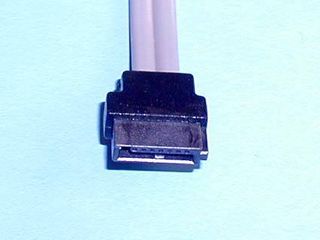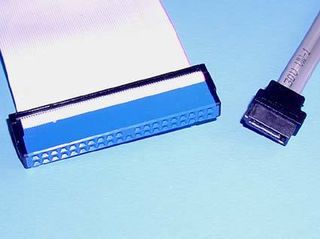Back To The Future: Serial ATA Arrives At Last
Finally: Thinner And Longer Cables

This is what the Serial ATA cable connector looks like.
Let's face it: ribbon cables can be an absolute pain. They have so many drawbacks. With a maximum length of only 40 cm, it is difficult or impossible to install drives at the top of a full tower case. Not only that, but the connectors are located at fixed positions along the cable, which means that you often have to move a drive to another bay so that the cable will reach. To top it off, the groove designed to prevent a reverse phase connection often necessitates that the plug be twisted around 180 degrees. In short: connecting more than one device to a ribbon cable is a job we wouldn't wish upon our worst enemy.
The reliability of the cable and its connectors leaves a great deal to be desired. A kink in the ribbon can easily put a cable out of action for good. Worst of all, the inevitable hodge-podge of IDE cables (up to six cables is common) prevents the free flow of air through the case, and thus interferes with system cooling.

Side by side, the difference is clear: 40-conductor IDE (left) compared to seven-conductor Serial ATA.
Serial ATA wins, by far. The new cables can be up to a meter in length, and they can be kept small and neat because they only need seven conductors. Even the polarity keyed plug is just eight millimetres wide. It is worth pointing out here that the Serial ATA Working Group is now working on Serial ATA II and Serial ATA III, which will offer transfer rates of 300 and 600 MByte/s, respectively.
Stay on the Cutting Edge
Join the experts who read Tom's Hardware for the inside track on enthusiast PC tech news — and have for over 25 years. We'll send breaking news and in-depth reviews of CPUs, GPUs, AI, maker hardware and more straight to your inbox.
Current page: Finally: Thinner And Longer Cables
Prev Page Back To The Future: Serial ATA Arrives At Last Next Page The Connections: Small And Hot-PluggableMost Popular

